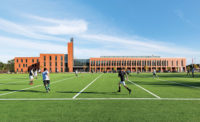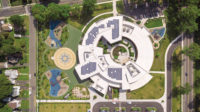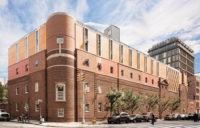Expansively spreading across the rise of a hill, the crescent-shaped Charles R. Drew Charter School for Junior and Senior Academies proudly embraces its pastoral campus near downtown Atlanta. “Curving the building was obvious, with this setting,” says Manuel Cadrecha, design principal of Perkins+Will (P+W), the architects. The 39-acre site, where groves of loblolly pines and bald cypress dot the landscape, is located near the Villages of East Lake, a mixed-income rental community, and the early-20th-century East Lake Golf Club, as well as the nine-hole Charlie Yates Golf Course.
In August 2014, the foundation followed with the bracingly bold structure by P+W for grades 6 through 12'junior- and senior-level college-prep academies'just up the hill from the elementary school. The optimism of the mission to educate an underserved demographic can be seen in the architectural treatment: the upper school's narrow 83-foot-wide classroom building accommodates classrooms, labs, studios, and offices in its 577-foot-long arcing form. Canted pencil-shaped steel columns with tapered cones increase in height toward the east end where the roof gently lifts upward. Ample amounts of ochre-tinged Tennessee fieldstone define the monumental entrance portal and end walls of the concrete-frame structure.
The concave facade faces south and west, where a glass curtain wall is sheltered from the sun by a deep overhanging concrete canopy and horizontal, louvered aluminum sunscreens. “We did so many solar studies,” says Barbara Crum, P+W principal in charge, noting that the architects and the school wanted to have as much daylight as possible within the teaching spaces, laboratories, and common areas.
At the back of the curvilinear building, slightly higher on the ridge, two separate, concrete'block and steel-frame wedge-shaped structures house the theater/auditorium and two gymnasiums. Because of the slope, a linear plaza in front of the theater and gym allows students to enter the main building's atrium at the second level.
The spatially fluid plan and the generous expanses of glass inside and out emphasize the school's commitment to a flexible curriculum, where educational activities can be easily viewed by faculty, students, and visitors. “The transparency of the spaces and the open plan help foster the program of collaboration and project-based learning,” says Peter McKnight, principal of the senior academy. McKnight refers to the teaching method in which teams of students tackle problems based on real-life situations. Rather than emphasizing traditional rote learning, the school encourages its students to think critically, communicate, and create through collaboration. The focus of the school on science, technology, engineering, arts, and mathematics (STEAM) can be seen in a project where ninth- and 10th-grade students worked with two teachers, one in engineering, the other in business technology, to make a remote-control lawn mower for a physically challenged resident who lives nearby. A recent cross-disciplinary assignment involving the visual arts and geography investigated subjects such as street art in the Middle East, while a mathematics and biology study called for designing a community health station.
To foster these new approaches to teaching and learning, the architects created open project labs for groups of 24 students, fitted with rolling chairs, wireless networks, and access to water and power. Presentation areas with flat-screen monitors are common, while noise is mitigated by hanging panels between beams of the exposed ceiling. “We like to reveal the structure to show students how buildings are made,” says P+W project manager John Poelker. Resilient flooring also cuts down on reverberation of school sounds.
A large, four-story atrium and stair with stadium seating at the main entrance acts as the lobby and circulation linchpin for the 205,000-square-foot school, separating the junior academy (currently 366 students) on the eastern end from the senior one (with 201 students) on the west. (The top floors for 11th and 12th grades remain unoccupied, awaiting lower grades to move up.)
Drew is seeking a LEED Gold certification with such sustainable components as high-performance glass, occupancy sensors to regulate electric lighting, reclaimed white oak, and local stone. Additionally, the design includes 180 photovoltaic panels on the theater building's roof that contribute to electricity supplies, a mechanical system based on a self-contained water-cooled unitary device (SWUD), and the harvesting of rainwater for irrigation.
The students seem to be responding well to the architecture of space and light and the sense of openness. One, Anastasia, said, “It's nice to have all the glass,” pointing out that “the classrooms are unique and the common areas flexible.” However, Amaya, another student, noted, “It's distracting when all the people on tours are staring at us while we are working.” Such are the problems with success. It has become an educational mecca.
People
Formal name of building:
Location:
Completion Date:
Gross square footage:
Total project cost:
Total construction cost:
Client:
Owner:
Architect:
Personnel in architect's firm who should receive special credit:
Landscape Design Principal: Leo Alvarez
Branded Environments Design Principal: Keith Curtis Registered architects: Crum, Cadrecha, Poelker, Jamgochian, Finn, Shah
Architect of record:
Interior designer:
Engineers:
Structural:
MEP:
Consultant(s): Food Service: Camacho Associates'James Camacho Theater: Stagefront Presentation'Jim Brawley Audio Visual: Waveguide'Lee Hutchins
Energy Modelling-Sustainability Consultant-Commissioning:
Furnishings:
General contractor:
Photographer(s): Gross square footage: 205,375 SF Total construction cost: $44,915,053 Completion date: July 2014 |
Products
Structural system
Exterior cladding Metal Panels: Berridge (Corrugated Metal Wall Panels) Metal/glass curtain wall: Kawneer 1600 system
Wood: EIFS, ACM, or other: Reynobond (Composite Aluminum Panels) Moisture barrier: Carlisle (MiraDri 860) Curtain wall: Kawneer 1600 system
Roofing
Windows
Doors Wood doors: Eggers
Fire-control doors, security grilles: Special doors: Eggers (sound-control doors)
Hardware Closers: PDQ Industries Exit devices: Von Duprin Pulls: PDQ Industries
Interior finishes Suspension grid: Armstrong Demountable partitions: Hufcor 632 Series
Cabinetwork and custom woodwork: Paints and stains: Sherwin-Williams Special surfacing: Sound tech acoustical wall covering Floor and wall tile: Daltile Resilient flooring: Forbo (MCT Marmoleum Composition Tile) Carpet: Tandus (Expedition at Center for the Arts, Intersection at Academic Building)
Furnishings
Private Offices: Teacher planning: Steelcase: “Kick” workstations; “Cobi” task chair Conference Rooms: Steelcase “Convene/Host” tables; “Think” seating Reception furniture: Steelcase “Jenny” guest lounge seating and Coffee Table; “Think” task seating Fixed seating: Greystone (Harmon)
Chairs:
Benches & Ottomans:
Tables:
Upholstery: Design Tex: “Pivot”
Lighting Downlights: Gotham Architectural Lighting Exterior: Lithonia Lighting; Cooper Lighting Dimming System or other lighting controls: Leviton (Occupancy Sensors)
Conveyance
Plumbing
Energy Photovoltaic system: Suniva (Optimus Series)
Other unique products that contribute to sustainability: |

















